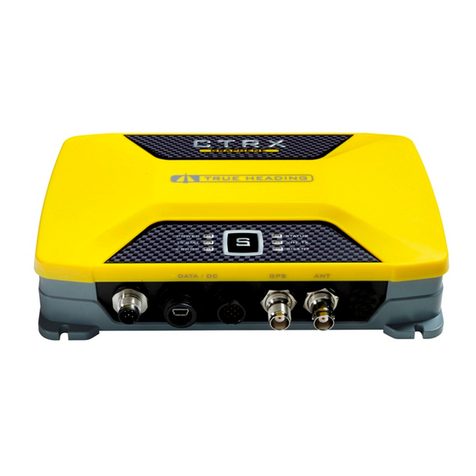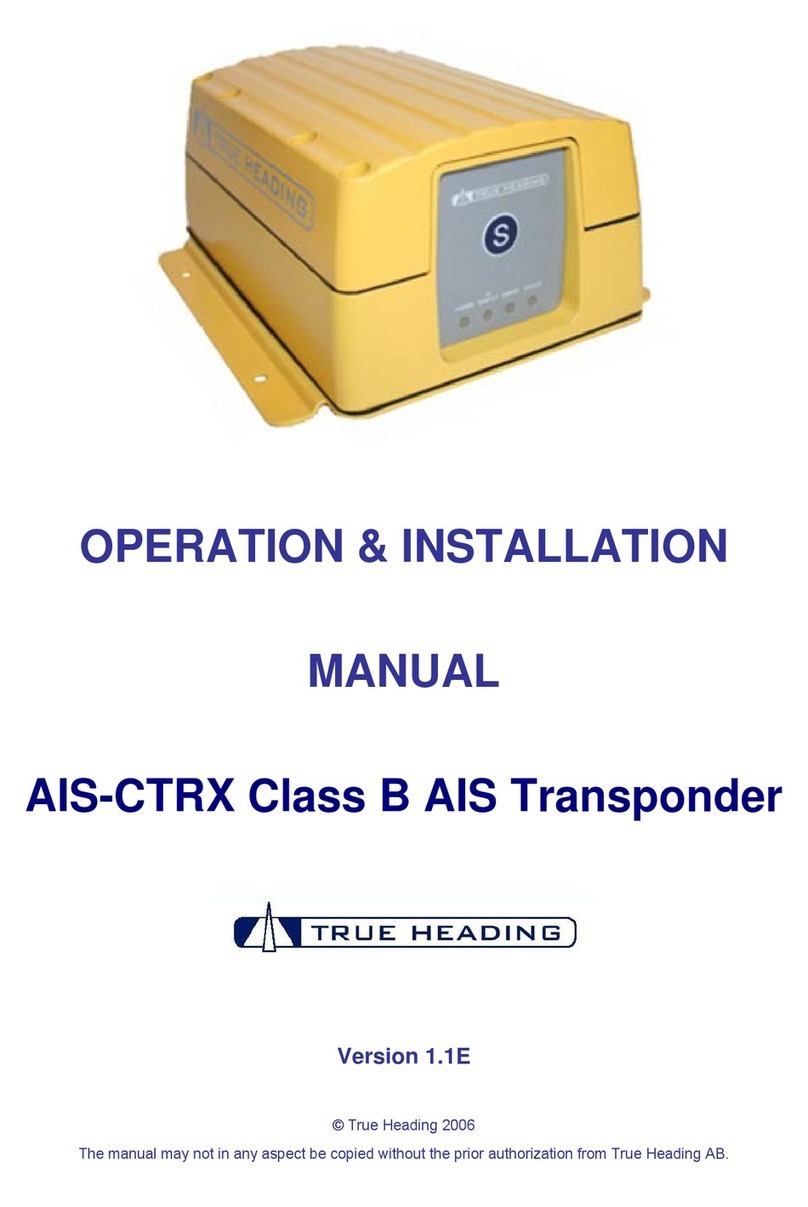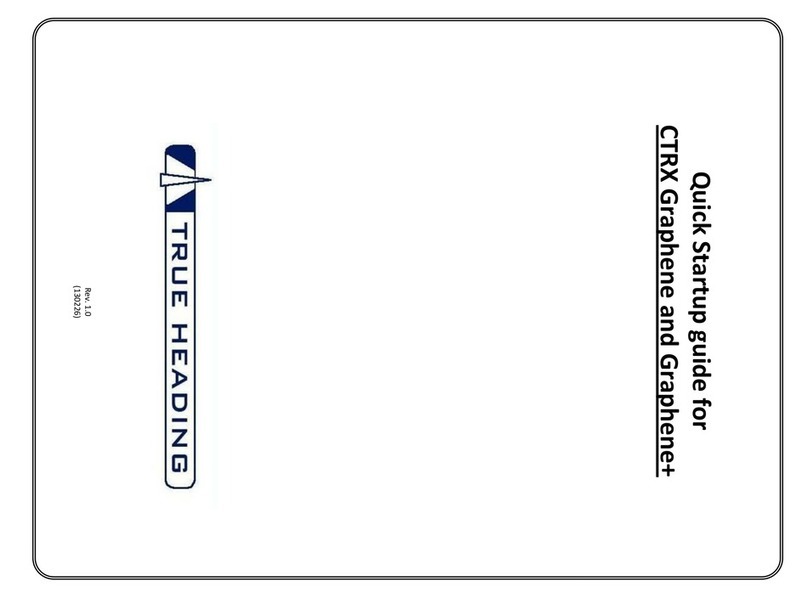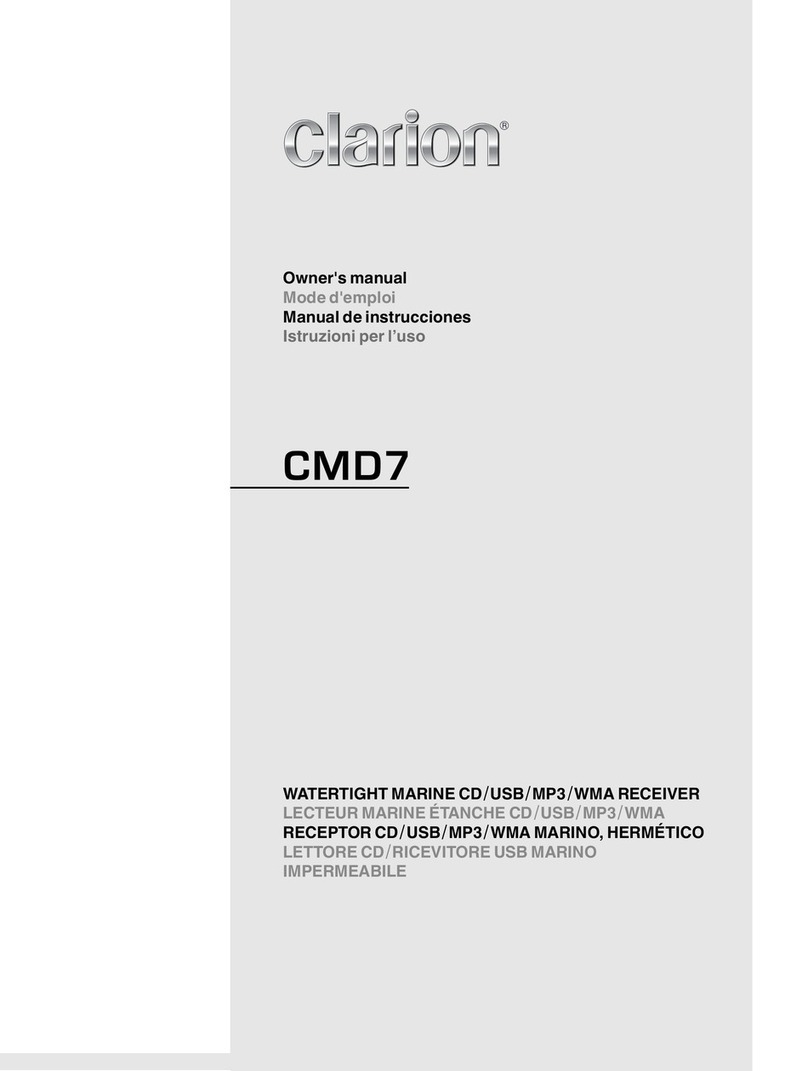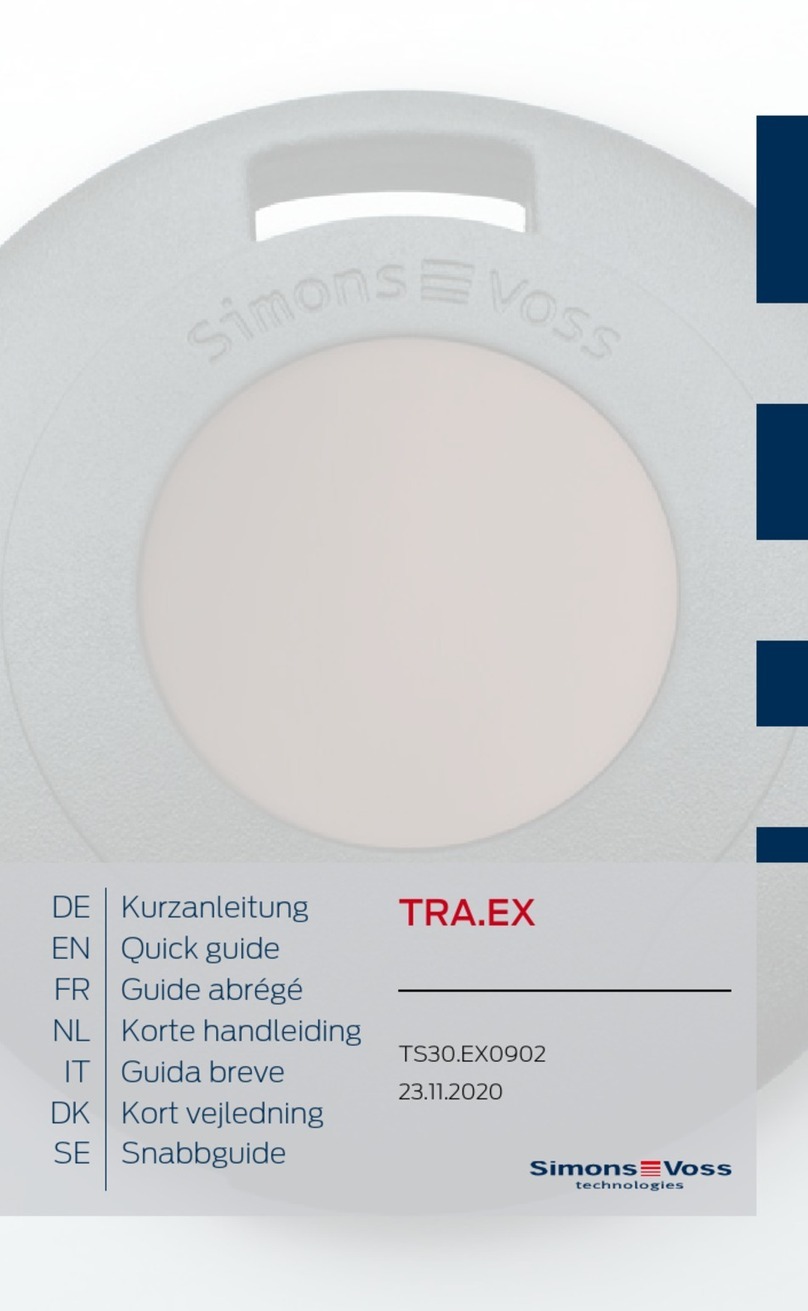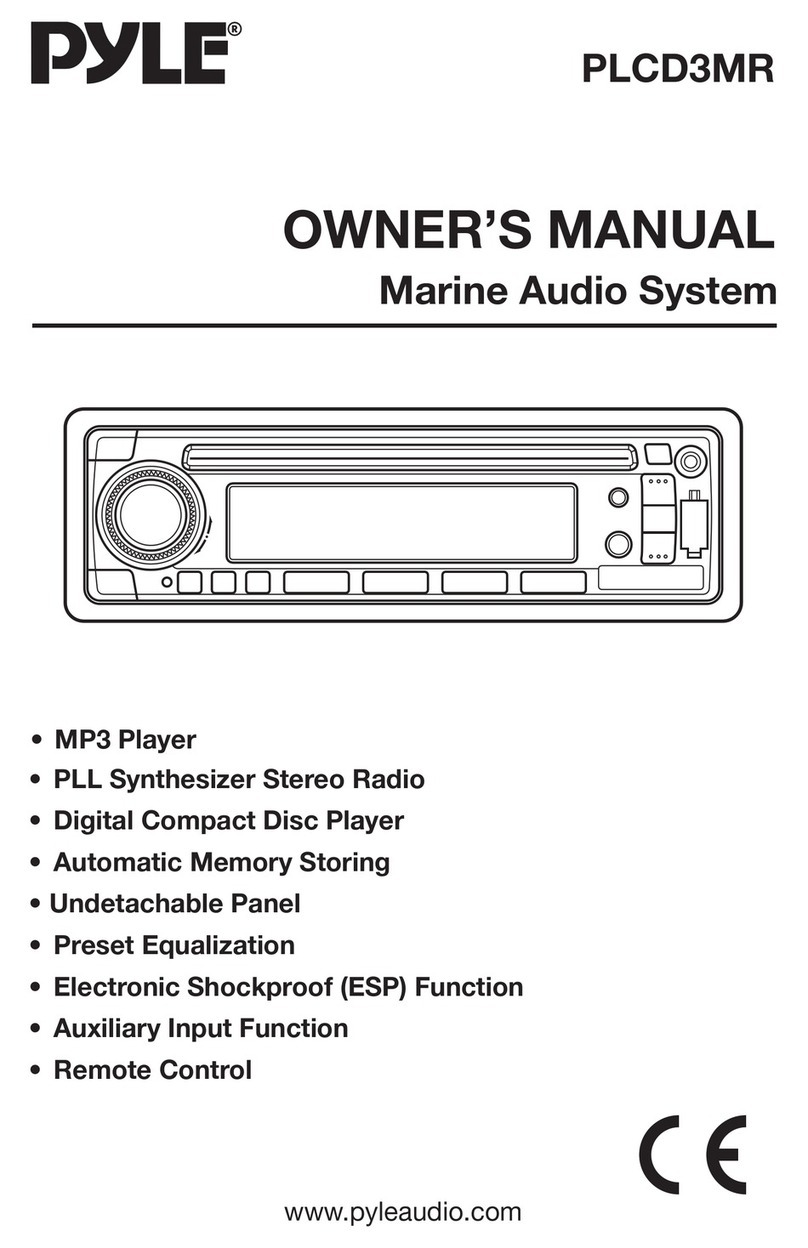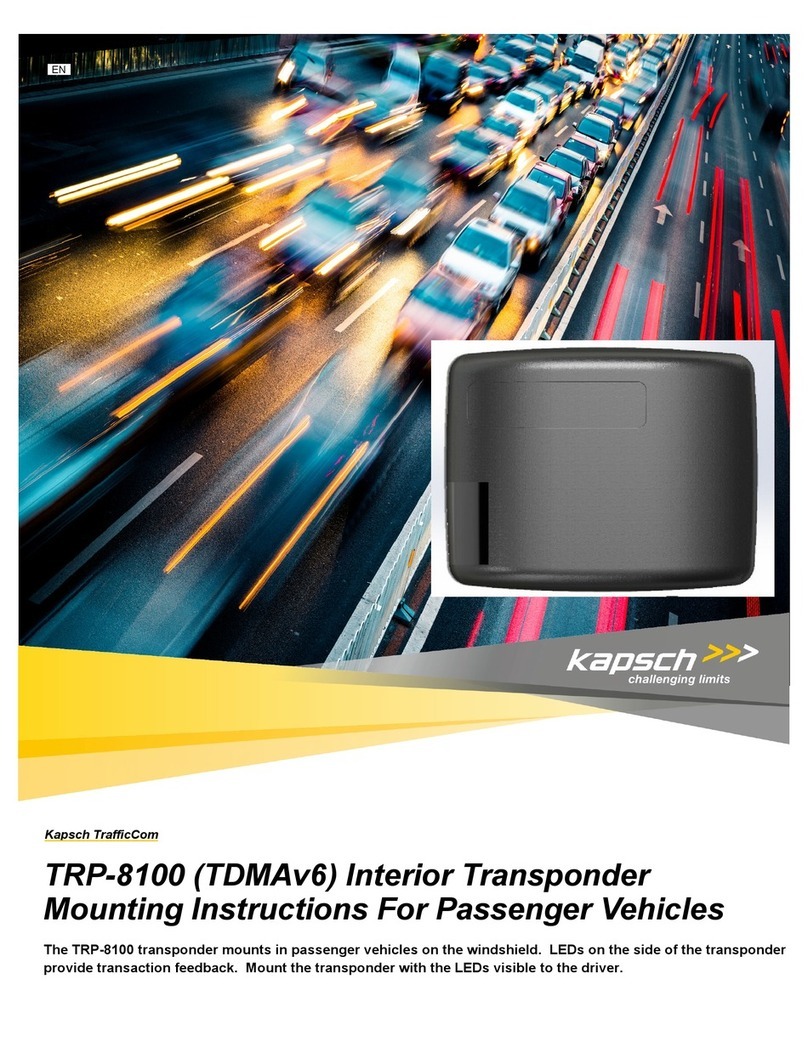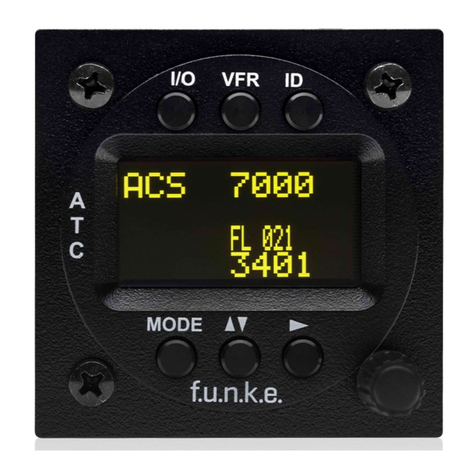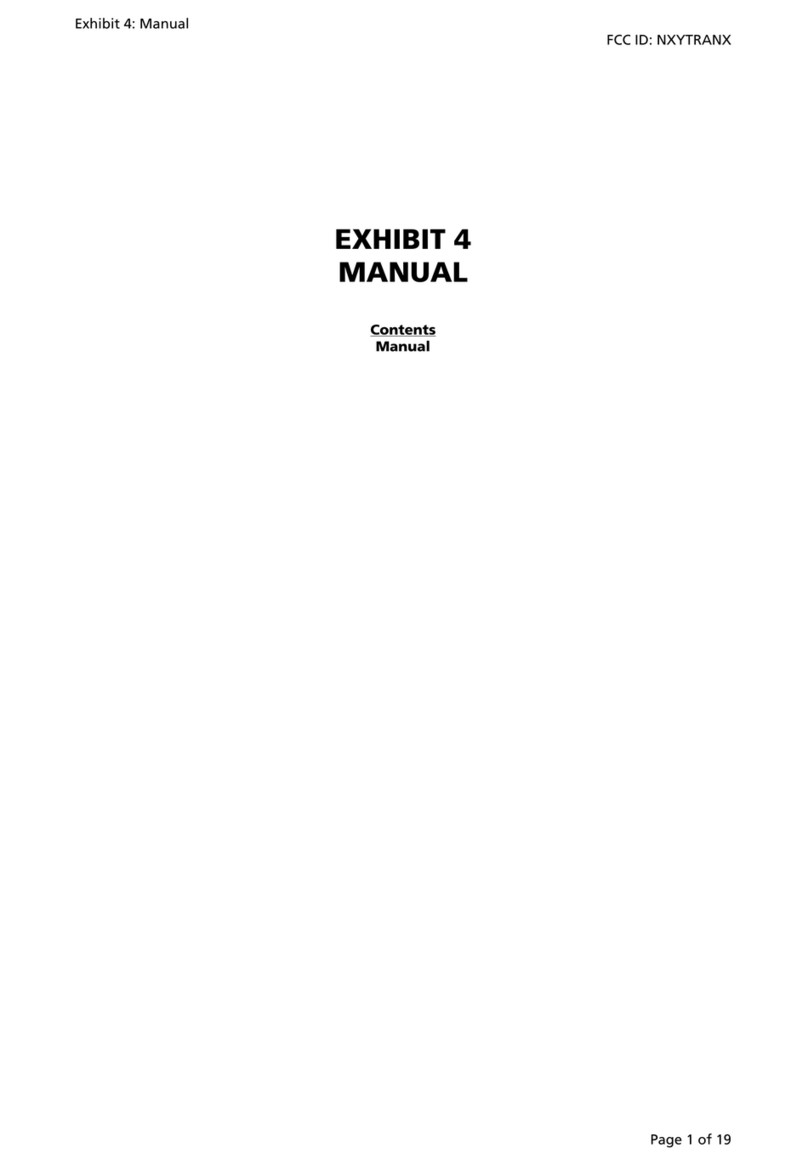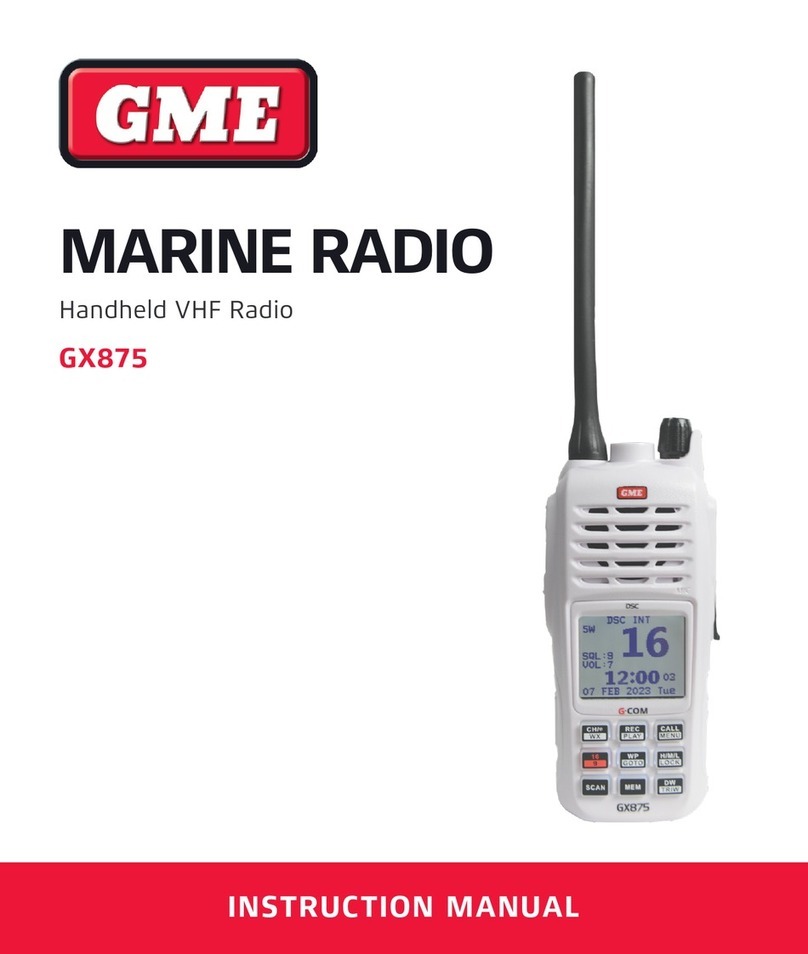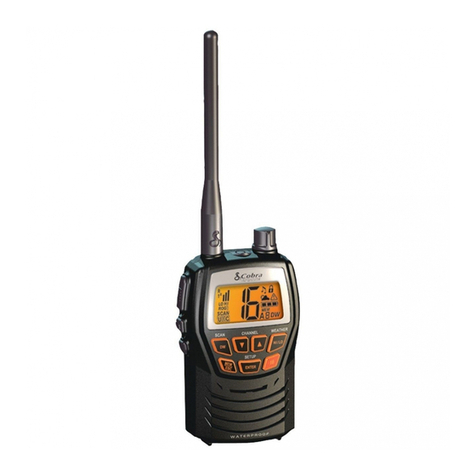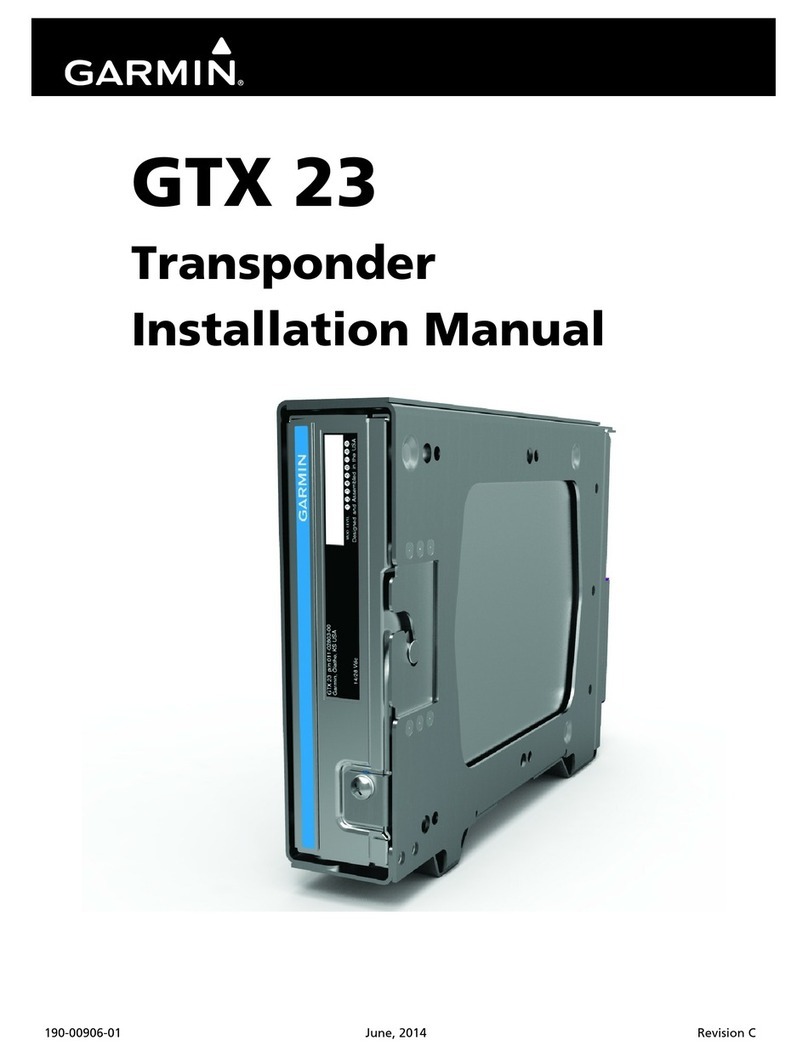True Heading AIS CTRX GRAPHENE User manual

OPERATION & INSTALLATION MANUAL
AIS CTRX GRAPHENE
Class B AIS Transponder
Version 1.4E
© True Heading 2013
The manual may not in any aspect be copied without the prior authorization from True Heading AB.

AIS CTRX GRAPHENE Class B AIS Transponder Manual
1.4E 2 CTRX GRAPHENE Manual
TABLE OF CONTENTS
TABLE OF CONTENTS ............................................................................................. 2
REVISION .................................................................................................................. 4
INTRODUCTION........................................................................................................ 5
GLOSSARY................................................................................................................ 6
CONDITIONS............................................................................................................. 8
WARRANTY............................................................................................................... 9
General.................................................................................................................... 9
Warranty conditions................................................................................................. 9
Warranty procedures............................................................................................... 9
Other issues ............................................................................................................ 9
SUPPORT................................................................................................................ 10
GENERAL NOTICE.................................................................................................. 11
LICENSING.............................................................................................................. 12
INFORMATION ABOUT AIS .................................................................................... 13
General.................................................................................................................. 13
Short technical description of AIS.......................................................................... 14
Limitations with AIS ............................................................................................... 15
PRODUCT SPECIFICATION ................................................................................... 16
Declaration of Conformity...................................................................................... 17
Getting started....................................................................................................... 18
INSTALLATION........................................................................................................ 20
HOW TO PROGRAM THE AIS CTRX GRAPHENE................................................. 28
SOME FREQUENTLY ASKED QUESTIONS........................................................... 36
NOTES..................................................................................................................... 38
Fixing Template..................................................................................................... 39
APPENDIX A ANTENNAS AND ANTENNA MOUNTING...................................... 40
GPS Antenna......................................................................................................... 40
VHF antenna for AIS use....................................................................................... 40
WARNINGS........................................................................................................... 40

AIS CTRX GRAPHENE Class B AIS Transponder Manual
1.4E 4 CTRX GRAPHENE Manual
REVISION
Version
Date
Responsible
Approved
Changes
1.0PE
2012-12-14
Anders Bergström
Nils Willart
Preliminary release
1.1PE
2013-03-08
Nils Willart
Update
1.2PE
2013-04-09
Nils Willart
Editorial
1.3PE
-
-
-
Intermediate, not used
1.4E
2013-05-21
Nils Willart
PGN list added

AIS CTRX GRAPHENE Class B AIS Transponder Manual
1.4E 5 CTRX GRAPHENE Manual
INTRODUCTION
We would like to thank you for choosing True Heading AB as supplier of your AIS Class B
Transponder. The AIS CTRX GRAPHENE is a high quality AIS Class B Transponder using the latest
technology. AIS CTRX GRAPHENE makes it possible to receive information from ships, buoys,
lighthouses, SAR helicopters, Coastguard units, Pilot boats, Weather station etc. and to send
information about your own ship to others that are equipped with Automatic Identification System (AIS)
transponders or receivers. SEE AND BE SEEN
It is today, according to the IMO SOLAS regulation a requirement for all ships above 300 GT to carry
AIS. This means that a large number of ships and other types of navigational information providers will
be seen by your AIS CTRX GRAPHENE and contribute to enhanced safety in your navigation.
Picture 1 Real traffic scenario between Sweden and Bornholm (Denmark)
It is of utmost importance that you read this manual before you start to install and use your AIS CTRX
GRAPHENE.

AIS CTRX GRAPHENE Class B AIS Transponder Manual
1.4E 6 CTRX GRAPHENE Manual
GLOSSARY
ACA (AIS) Regional Assignment Channel Assignment Message
ACK Acknowledgement
ACS (AIS) Channel management information source messages
AFSK Audio frequency-shift keying
ALR (AIS) Alarm Message
A to N Aid to Navigation
AIS Automatic Identification System
ATC Air Traffic Control
BIIT Built In Integrity Testing
BNC Bayonet fitting type RF connector
CSTDMA Carrier Sense Time Division Multiple Access
COG Course over Ground
CR Carriage Return
CS Carrier Sense
CSTDMA Carrier Sense TDMA
DC Direct Current
DGNSS Differential Global Navigation Satellite System
DGPS Differential Global Positioning System
DSC Digital Selective calling
ETA Estimated Time of Arrival
GALILEO European equivalent to GPS
GLONASS Global Navigation Satellite System
GNSS Global Navigation Satellite System
GMSK Gaussian Minimum Shift Keying
GPS Global Positioning Satellite / System
HF High Frequency
IMO International Maritime Organization
IEC International Electrotechnical Commission
LED Light Emitting Diode
LF Line Feed
LNA Low-noise amplifier
MF Medium Frequency
MKD Minimum Keypad and Display
MMSI Maritime Mobile Service Identity
MPE Maximum Permissible Exposure
NM Nautical Mile = 1852 m
NMEA National Marine Electronics Association
PC Personal Computer

AIS CTRX GRAPHENE Class B AIS Transponder Manual
1.4E 7 CTRX GRAPHENE Manual
PI Presentation Interface
RF Radio Frequency
RTCM Radio Technical Commission for Maritime Services Commission
RX Receive or Receiver
RFI Radio frequency interference
SAR Specific Absorption Rate
SELV Separated Extra Low Voltage
SMA Swedish Maritime Administration
SMS Short Message System
SOG Speed over Ground
SOLAS Safety Of Life At Sea
SOTDMA Self Organized Time Division Multiple Access.
SRM Safety Related Message
SRT Software Radio Technology
TDMA Time-division Multiple Access
TNC Threaded type BNC connector
TX Transmit or transmitter
UTC Universal Time Co-ordinated
VDM (AIS) VHF Data Link Messages
VDO (AIS) VHF data link own vessel messages
VHF Very High Frequency
VTS Vessel Traffic Services (Like ATC but for ships)
VSWR Voltage Standing Wave Ratio

AIS CTRX GRAPHENE Class B AIS Transponder Manual
1.4E 8 CTRX GRAPHENE Manual
CONDITIONS
Before you start using the AIS CTRX GRAPHENE product from True Heading AB it is important that
you read and fully understand the installation manual and its instructions. You should only proceed
with the installation if you are confident that you will be able to do so.
True Heading AB cannot be held liable for any injury or damage caused by, during or because of the
installation of AIS CTRX GRAPHENE. The AIS CTRX GRAPHENE is used at your own risk and it
shall be remembered that AIS and GPS data depends on the full co-operation of other users and
systems.
AIS CTRX GRAPHENE is a navigation aid and works in co-operation with other similar systems like
e.g. radar, optical lookout etc. The AIS CTRX GRAPHENE installation should be inspected from time
to time and checked on its operational quality frequently by the user. Remember that navigation and
life at sea always requires proper seamanship and that the AIS CTRX GRAPHENE is not a
replacement for such qualities.
NOT ALL VESSELS CARRY AIS. IT IS THEREFORE IMPORTANT TO KEEP PROPER LOOKOUT
AT ALL TIMES AND TO USE ALL AVAILABLE MEANS TO AVOID COLLISIONS AND
ACCIDENTS.
GPS MAY FROM TIME TO TIME INCLUDE ERRORS: THEREFORE, THE POSITION RECEIVED
FROM THE GPS BUILT IN TO AIS CTRX GRAPHENE SHALL ALWAYS BE VERIFED WITH
OTHER AVAILABLE MEANS.

AIS CTRX GRAPHENE Class B AIS Transponder Manual
1.4E 9 CTRX GRAPHENE Manual
WARRANTY
General
AIS CTRX GRAPHENE is developed and manufactured to meet high technical requirements and user
demands. If installed correctly and with regular maintenance your AIS CTRX GRAPHENE should
provide you with several years of operation and a very useful product. For further information provided
in the manual and in this information sheet please consult the place where you purchased the AIS
CTRX GRAPHENE or direct to our support.
Warranty conditions
- The warranty belongs to the person that purchased the product and cannot be handed over to a third
party or person.
- The warranty is not valid if serial number is missing, seals broken or if the AIS CTRX GRAPHENE
has been incorrect installed. Neither is the warranty valid if instructions for connection have not been
followed, faults caused by wrong usage, own made modifications or service made from none
authorized service stations.
- True Heading AB acknowledges that AIS CTRX GRAPHENE at delivery has been controlled and
found operational.
- True Heading AB agrees to repair or replace any faulty unit without any cost according to the
conditions set forth during a period of two (2) years from day of purchase.
- The warranty includes replacement or repair of faulty unit due to error in components or errors in
relation to the production of the product.
- The warranty covers costs for spares, labor, and return shipment. It does not include shipment from
to the repair facility.
- True Heading AB will never be liable under the warranty conditions for incorrect use, misuse, and
incidental, indirect or consequential damages of the AIS CTRX GRAPHENE.
- Proof of purchase is required for any warranty claim of the AIS CTRX GRAPHENE.
Warranty procedures
True Heading AB repairs and replaces faulty parts or units. The customer is responsible for transport
of the defect part or unit to True Heading or its retailer.
Warranty claims shall be made to the place where AIS CTRX GRAPHENE was purchased or direct to
True Heading AB through mail, fax or e-mail to our support department.
Other issues
Proper seamanship and common sense is applicable when using AIS CTRX GRAPHENE and the
products shall only be seen as a navaid. True Heading AB keeps the right to change the specification
of the product without prior notice.
IF YOU ARE NOT ABLE TO ACCEPT THE TERMS ABOVE, PLEASE RETURN THE AIS CTRX
GRAPHENE TO YOUR RETAILER FOR FULL CREDIT BEFORE OPENED AND USED.

AIS CTRX GRAPHENE Class B AIS Transponder Manual
1.4E 10 CTRX GRAPHENE Manual
SUPPORT
If you need support, please contact the closest reseller or the location where you acquired the product.
The manufacturer will only provide support direct if these procedures are followed. The support case
has to be registered properly through our webpage at www.trueheading.se .
In order to ensure receipt of important information and to protect your guarantee you can register your
AIS CTRX GRAPHENE purchase at True Heading AB by sending an e-mail to
and where you bought your equipment.
In accordance with our policy to always offer development and enhancements of our products, and
future versions of AIS CTRX GRAPHENE may differ somewhat from this manual. Updated versions of
the manual are always available for download at our homepage www.trueheading.se .
The information in this manual is subject to change without prior notice or information thereof.
© 2012 True Heading AB

AIS CTRX GRAPHENE Class B AIS Transponder Manual
1.4E 11 CTRX GRAPHENE Manual
GENERAL NOTICE
The Automatic Identification System (AIS) unit mostly utilise a Global Navigation Satellite
System (GNSS) system such as e.g. GPS or GLONASS to determine position.
The accuracy of these systems is variable and can be affected by factors such as the
positioning of the antenna, the number of satellites available to determine a position and for
how long satellite information has been received.
It is desirable as often as possible to verify both your vessel’s AIS derived position data and
other vessels AIS derived position data with visual or radar based observations.
The compass safe distance of this unit is 0.5m or greater for 0.3° deviation.

AIS CTRX GRAPHENE Class B AIS Transponder Manual
1.4E 12 CTRX GRAPHENE Manual
LICENSING
IMPORTANT: In most countries the operation of an AIS unit is included under the vessels marine VHF
radio licence provisions. The vessel on to which the AIS unit is to be installed must therefore possess
a valid VHF radiotelephone licence which lists the AIS system and the vessel Call Sign and MMSI
number.
Please contact the relevant authority in your country for more information.
In accordance with our policy of continuous development and product improvement the AIS CTRX
GRAPHENE hardware and/or software may be upgraded from time to time and future versions of the
AIS CTRX GRAPHENE may therefore not correspond exactly with this manual.
When necessary upgrades to the product are made, these will be accompanied by updates or
addenda to this manual.
Please take time to read this manual carefully to understand its contents fully so that you can install
and operate your AIS system correctly.
Information contained in this manual is liable to change without notice.
True Heading AB disclaims any liability for consequences arising from omissions or inaccuracies in
this manual and any other documentation provided with this product.
© 2013 True Heading AB

AIS CTRX GRAPHENE Class B AIS Transponder Manual
1.4E 13 CTRX GRAPHENE Manual
INFORMATION ABOUT AIS
General
AIS (Automatic Identification System) is the name of a system that makes it possible for ships to
identify other ships and to monitor ship movements. The reason for implementing the AIS system is for
the mariner to obtain more information about ships in the vicinity than what radar is able to provide.
AIS gives e.g. information about a ships identity (name, call sign, IMO number and MMSI), size this
even for ships behind Island or bends that radar cannot detect.
AIS is used to enhance safety for life at sea, improve safety and efficiency in navigation and protect
the marine environment.
AIS-information transmitted from a ship contains of three (3) different main types:
- Static data that was programmed into the AIS equipment at installation and it only needs to be
changed if the ship changes its name, flag or undergoes a major refit where size or ship type is
changed;
- Dynamic data contains information that automatically is updated from ship sensors like the heading
from the Gyro, Position and speed from GNSS equipment. Also navigational status belongs to the
group of dynamic data but is updated manually by the crew; and
- Voyage related data that manually is updated by the crew along the voyage.
From the start AIS sometimes also was referred to as UAIS or as the 4S transponder system that
meant Ship to Ship and Ship to Shore.
IMO adopted 1998 a performance standard for AIS within the SOLAS requirement that described in
general how AIS should work. Below follows a brief description of the main requirements for AIS from
the performance standard:
Automatically provide information to AIS land stations, other ships and airborne units e.g. SAR
helicopters about the ships identity, Type of ship, Position, Course, Speed, Navigational status
(e.g. under way using engine, at anchor) and other safety related information of importance.
Be able to receive the same type of information from other ships.
Be able to monitor and track other ships.
Exchange information with land based AIS systems.
AIS is an automatic system that continuously and simultaneously transmits on two channels in the
maritime VHF frequency band.
AIS can handle several reports in a rapid consecutive flow. To accomplish this AIS uses a technique
called Self Organized Time Division Multiple Access (SOTDMA) that guarantees high transmission
safety and operational robustness.
AIS also allows for other types of information from e.g. sensors like Gyro, GPS and echo sounders etc.
to be transmitted automatically.
Important areas where AIS is used are:
Information exchange between ships within VHF range (normally 20-30 NM) to enhance
safety at sea and to improve situation awareness.

AIS CTRX GRAPHENE Class B AIS Transponder Manual
1.4E 14 CTRX GRAPHENE Manual
Information exchange between ships and AIS land stations as e.g. a VTS that controls and
monitors maritime traffic in an area.
Automatic reporting in areas with mandatory reporting of different kinds.
Exchange of safety related information between ships and between ships and land stations.
Services like e.g. meteorological information in real-time from areas of importance, identity
and position of floating and fixed aids to navigation to improve identification and navigation.
How AIS Works
The marine Automatic Identification System (AIS) is a location and vessel information reporting
system. It allows vessels equipped with AIS to automatically and dynamically share and regularly
update their position, speed, course and other information such as vessel identity with similarly
equipped craft. Position is derived from a Global Navigation Satellite System (GNSS) network and
communication between vessels is by Very High Frequency (VHF) digital transmissions. A
sophisticated and automatic method of time sharing the radio channel is used to ensure that even
where a large number of vessels are in one location blocking of individual transmissions is minimised,
any degradation of the expected position reporting interval is indicated to the user and even if the unit
suffers extreme channel overload conditions it will always recover to normal operation.
AIS Classes
There are two classes of AIS units fitted to vessels, Class A and Class B. In addition AIS base stations
may be employed by the Coastguard, port authorities and other authorised bodies. AIS units acting as
aids to navigation (A to N) can also be fitted to fixed and floating navigation markers such as channel
markers and buoys.
Class A units are a mandatory fit under the safety of life at sea (SOLAS) convention to vessels above
300 gross tons or which carry more than 11 passengers in International waters. Many other
commercial vessels and some leisure craft also fit Class A units.
Class B units are currently not a mandatory fit but authorities in several parts of the world are
considering this. Class B units are designed for fitting in vessels which do not fall into the mandatory
Class A fit category.
The AIS CTRX GRAPHENE is a Class B unit
Position Information Source
As noted above the marine AIS system uses position information derived from networks such as the
Global Positioning Satellite (GPS) or the Global Navigation Satellite System (GLONASS) in order to
determine the location of the AIS unit and thus the vessel to which it is fitted.
Short technical description of AIS
AIS operates primarily on two dedicated VHF-frequencies (AIS1 –161,975 MHz and AIS2 –162,025
MHz). In areas where these two channels are not available, AIS can automatically change to other
alternatively available frequencies.
AIS uses two VHF radio channels, where the information is transmitted in short data packages or slots
in predefined and synchronized time frames. The dynamic information (position, speed, heading etc)
is transmitted in intervals from 2s up to 10s depending on the manoeuvres of the transmitting ship
were the AIS is mounted. Static and voyage related information (type of ship, size, cargo, destination
etc.) is transmitted every sixth minute or upon request from other units. Position, course and speed

AIS CTRX GRAPHENE Class B AIS Transponder Manual
1.4E 15 CTRX GRAPHENE Manual
normally are collected from the same sensor systems that provides the same information used in the
navigation e.g. in radars or ECDIS and this is normally based on GPS or DGPS. All ships within VHF
coverage will be able to receive AIS data and competent authorities that have installed networks with
coastal AIS coverage can receive the information. The capacity for the ships to report is defined by the
IMO performance standard to a minimum of 2000 data packages or slots per minute (see picture 2).
ITU (Technical Standard for the Universal AIS) has been kind to double this and has provided AIS with
4500 data packages or slots per minute. The transmission is based on the (SO)TDMA (Self-organized
Time Division Multiple Access) technique, that allows the system to overload with 400 till 500 % and
still give almost a 100 % message throughput between ships that are closer to each other than 8 to 20
nautical miles. In such case the system overloads targets far away will be discriminated in favor of
targets close to your own ship. In reality, the system capacity is unlimited and allows for a large
number of ships to communicate simultaneously.
Picture 2 The principle of AIS technology on the two radio channels.
Limitations with AIS
You should always be aware that all ship others ships and in particular pleasure crafts, fishing boats,
warships and some coastal stations and VTS not will be equipped with AIS. Ships that have been
mandated to carry AIS can also under certain conditions turn of their AIS equipment at the master’s
disgrace. Therefore it is important to be aware that the information that AIS provides might not be the
full and complete picture of the situation around your ship.
Users of AIS must also be aware that transmission of false data can occur and that this will be
hazardous not only to your own ship but to other as well. The user is responsible for all data that is
entered into the system and for information provided by external sensors. The accuracy of received
AIS data is only as good as the information transmitted from the source of information.
You should always be aware that wrong configured or calibrated ship sensors (positions-, speed- or
heading sensors) could lead to that wrong information will be transmitted. Dangerous situations can
occur if faulty information is shown on another ship.

AIS CTRX GRAPHENE Class B AIS Transponder Manual
1.4E 16 CTRX GRAPHENE Manual
PRODUCT SPECIFICATION
Dimensions: 210 x 144 x 50 mm (L x W x H)
Weight: 0,45 kg GRAPHENE, 0,5 kg GRAPHENE+
Power: DC 12-24V (min. 10V, max. 32V)
Average power consumption 4W (GRAPHENE)
Average power consumption 4.5 W (GRAPHENE+)
350 mA@12 VDC (receiving)
Peak current rating: 1.2A @ 12VDC (transmitting)
GPS Receiver (AIS Internal): IEC 61108-1 compliant
50 channels
Data Interfaces: USB
NMEA 2000 LEN (Load Equivalence Number) = 1
NMEA 0183, RS422 38400 baud
Connectors: VHF Antenna connector = BNC (Female)
GPS Antenna connector = TNC (Female)
USB B serial data (USB mini connector)
Combined NMEA 0183/DC power connector
NMEA2000 connector
VHF Radio = FME (Male) -GRAPHENE+ only
VHF Transceiver: 1 Transmitter, 2 Receivers
Frequency: 156.025 to 162.025 MHz
Receiver sensitivity: <- 110dBm @ 20% PER
RF Output Power: 2 W (50Ω)
Channel Bandwidth: 25 kHz
Data Bit rate: 9600 b/s ± 50 ppm (GMSK) AIS
1200 b/s ± 30 ppm (FSK) DSC
Environmental: IEC 60945, Operating Temperature: -15ºC to +55ºC
IEC 62287, Section 5, Cat c) exposed to the weather
Compass safe distance: 0.5m or more for 0.3° deviation.
LED indicators: POWER - Green
STATUS - Green
TX STAT - Yellow
ERROS - Red
VHF TX - Yellow
SILENT- Blue

AIS CTRX GRAPHENE Class B AIS Transponder Manual
1.4E 17 CTRX GRAPHENE Manual
Standards
This product complies with all the necessary standards under the European R&TTE directive for
Article 3.1(a), 3.1(b), 3.2 and 3.3(e). The following standards have been followed in pursuance of this:
IEC62287-1, Ed2: 2006-03 Maritime navigation and radio communication equipment and systems –
Class B ship borne equipment of the automatic identification system (AIS) –Part 1: Carrier-sense time
division multiple access (CSTDMA) techniques
IEC60945, Ed4: 2002-08 Maritime navigation and radio communication equipment and systems –
General requirements –Methods of testing and required test results
IEC61162-1, Ed2: Maritime navigation and radio communication equipment and systems –Digital
interfaces –Part 1: Single talker and multiple listeners
IEC61108-1: GLOBAL NAVIGATION SATELLITE SYSTEMS (GNSS) –Part 1: Global positioning
system (GPS) -Receiver equipment - Performance standards, methods of testing and required test
results
EN 301 843-1 v2.1: Electromagnetic compatibility and Radio spectrum Matters (ERM);
Electromagnetic Compatibility (EMC) standard for marine radio equipment and services; Part 1:
Common technical requirements
EN 50383: 2002 Basic standard for calculation and measurement of electromagnetic field strength and
SAR related to human exposure from radio base stations and fixed terminal stations for wireless
telecommunications system (110MHz –40GHz)
EN60950-1:2002 Information technology equipment –Safety –Part 1: General requirements
NMEA2000 Edition 2.20
Declaration of Conformity
True Heading AB declares that this product is in compliance with the essential requirements and other
provisions of the R&TTE directive 1995/5/EC.
The product carries the CE mark, notified body number and alert symbol as required by the R&TTE
directive
This True Heading product can be used in the following European Community and EFTA Contries:
AT
BG
BE
CY
CZ
DK
EE
FI
FR
DE
GR
HU
IE
IT
LV
LT
LU
MT
NL
PL
PT
RO
SK
SL
ES
SE
GB
IS
LI
NO
CH

AIS CTRX GRAPHENE Class B AIS Transponder Manual
1.4E 18 CTRX GRAPHENE Manual
Getting started.
Before AIS CTRX GRAPHENE is installed, you should check that you have all the
equipment you need for the installation and that nothing is missing from your
delivery. The AIS CTRX GRAPHENE comes in two versions the GRAPHENE and the
GRAPHENE+ version. The plus version also contains a built in antenna splitter
making it possible to use the same VHF antenna for both the AIS and the VHF radio.
AIS CTRX GRAPHENE comes with the following parts:
1
AIS CTRX GRAPHENE Class B Transponder
P/N 0012-001-000
1
Data and DC cable (1 m)
P/N 0012-770-000
1
USB cable 1 m
P/N 0012-980-000
1
BNC to UHF adapter
P/N 0012-989-000
1
CD incl. manual, set up software and AIS information
P/N 0012-972-000
AIS CTRX GRAPHENE + comes with the following parts:
1
AIS CTRX GRAPHENE Class B Transponder
P/N 0012-002-000
1
Data and DC cable (1 m)
P/N 0012-770-000
1
USB cable 1 m
P/N 0012-980-000
1
BNC to UHF adapter
P/N 0012-989-000
1
Cable (2 m) AIS to VHF with connectors
P/N 0010-980-000
1
CD incl. manual, set up software and AIS information
P/N 0012-972-000
The following may be needed to finish your installation but is not included:
1
VHF marine band antenna with cable and UHF or
BNC type coaxial connector.
1
GPS antenna (active antenna, built-in LNA, 20dB gain
min., 5VDC) with cable and TNC coaxial connector
2
3A Fuse with fuse holder
1
DC cable, for the DC power installation
4
Mounting screws
1
Installation materials such as mounts for the
antennas, cable ties, screws, connection blocks etc.

AIS CTRX GRAPHENE Class B AIS Transponder Manual
1.4E 19 CTRX GRAPHENE Manual
Before you begin the installation, you should decide on where you want to place your
AIS CTRX GRAPHENE unit.
Note the following:
Place the transponder in such a way that you will be able to see the LED’s on the
front. This will make it easy to monitor the functions and make sure that the unit is
working properly.
The transponder should be installed in a place where the length of the antenna
cables can be kept as short as possible, but also where DC power and access to
other equipment you would want to connect the AIS to is conveniently available.
AIS CTRX GRAPHENE has 3 data ports. 2 of them are preferably used for the
connection to a plotter (the NMEA0183/RS422 or the NMEA 2000 port). A USB port
(mini type) is available for connection to a PC. This is used for the configuration of
the unit as well as maintenance or use with a PC navigation solution.
If you are installing the AIS CTRX GRAPHENE+ version or using a Class B VHF
splitter with the standard CTRX Graphene it is recommended that you connect the
DC leads it to the same power source as your VHF.
There are antennas available specifically made for use with AIS equipment but any
standard type marine band VHF antenna will work. Place your VHF antenna as high
as possible but at least 2.5-3 m above the water surface. If you are installing a
separate AIS antenna you should make sure that it is separated as much as possible
from other VHF antennas to avoid interference.
GPS antennas should be installed in such a way that the antenna top surface has a
free and unobstructed view of the horizon. Make sure that the antenna is not placed
nearby metal objects in order to minimize reflections of the received signal. GPS
antennas should not be placed in the vicinity of high power HF or satellite
communications equipment.

AIS CTRX GRAPHENE Class B AIS Transponder Manual
1.4E 20 CTRX GRAPHENE Manual
INSTALLATION
Once you have unpacked the box and checked that your delivery is complete,
proceed with the installation as follows:
Figure 5 AIS CTRX GRAPHENE + with its antennas and data/DC connectors
The 12 pole multi-pin connector mounted on the transponder has the following
configuration of the pins:
Pin
Signal
Color marking
1
Signal ground
BROWN
2
Power supply Voltage GND (-)
BLUE
3
SILENT LED (Blue)
WHITE
4
Signal ground
GREEN
5
NMEA 0183/RS-422 TX B (-)
YELLOW
6
NMEA 0183/RS-422 TX A (+)
GREY
7
NMEA 0183/RS-422 RX A (+)
PINK
8
Power supply Voltage (+)
RED
9
Power supply Voltage GND (-)
BLACK
10
Power supply Voltage (+)
ORANGE
11
External SILENT switch
PURPLE
12
NMEA 0183/RS-422 RX B (-)
LIGHT GREEN
Table 1. Data/DC connector configuration
Other manuals for AIS CTRX GRAPHENE
1
Table of contents
Other True Heading Marine Radio manuals
Popular Marine Radio manuals by other brands

SEA
SEA 330 Operator's manual

Cobra Marine
Cobra Marine Marine MR HH125 Manual del propietario
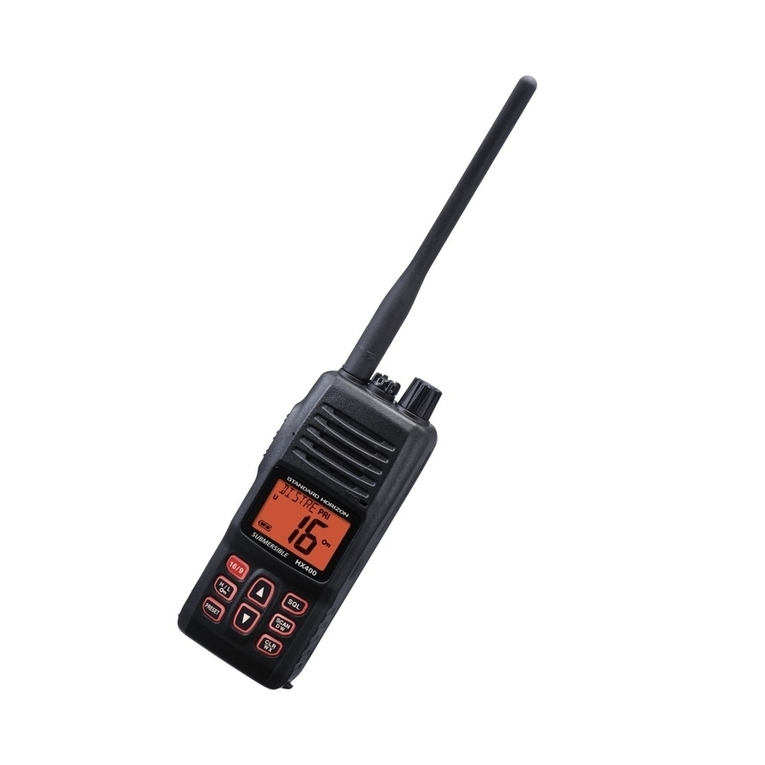
Standard Horizon
Standard Horizon HX400 owner's manual
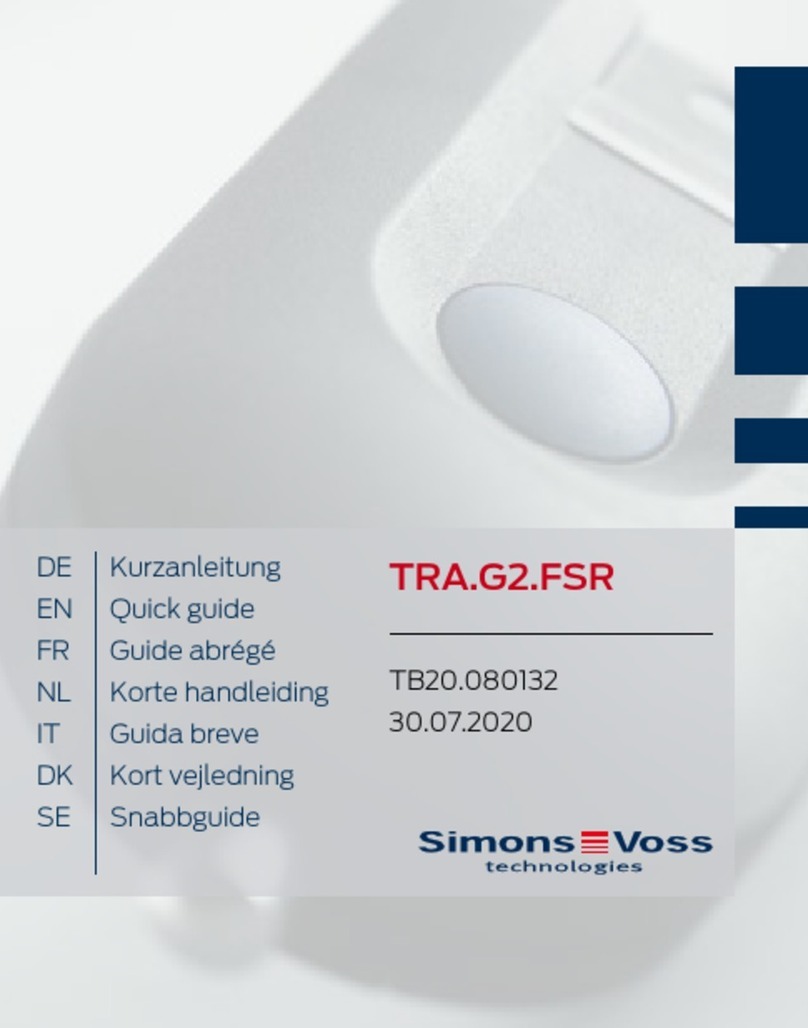
Simons Voss Technologies
Simons Voss Technologies TRA.G2.FSR quick guide
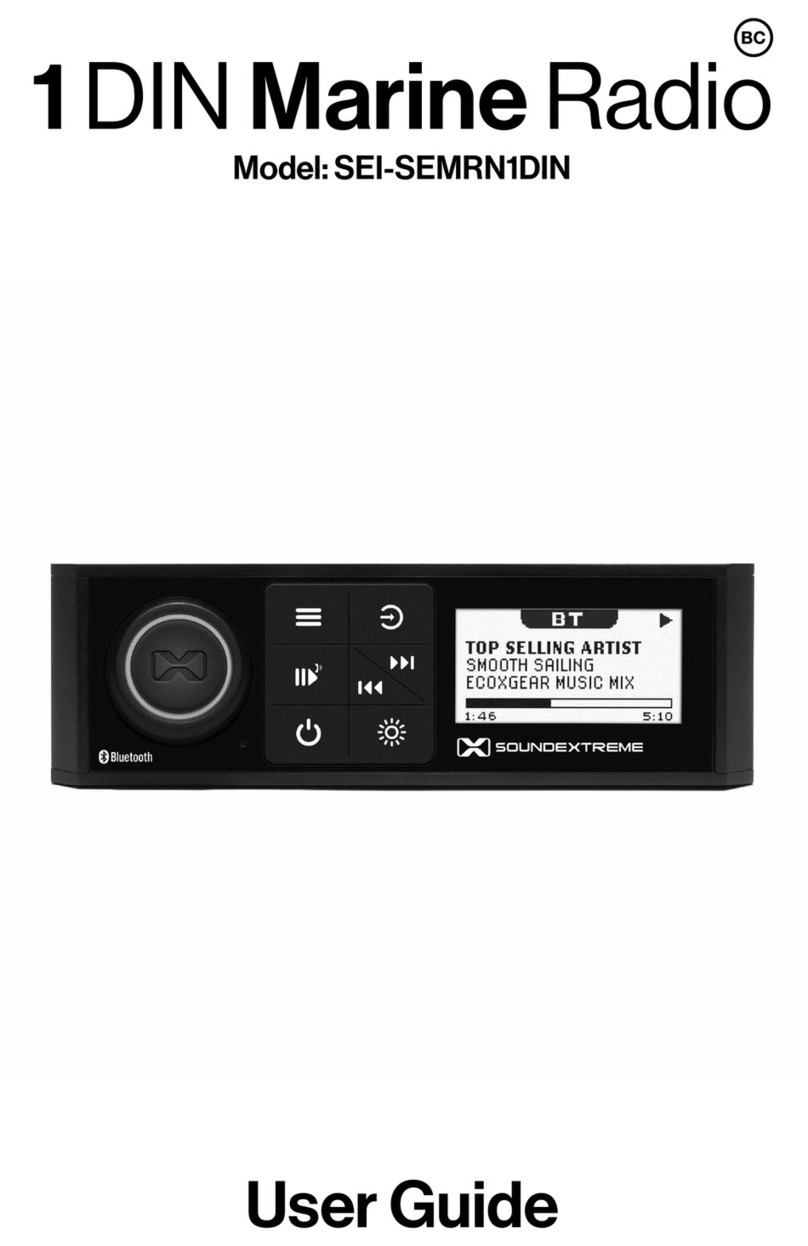
EcoxGear
EcoxGear SOUNDEXTREME SEI-SEMRN1DIN user guide
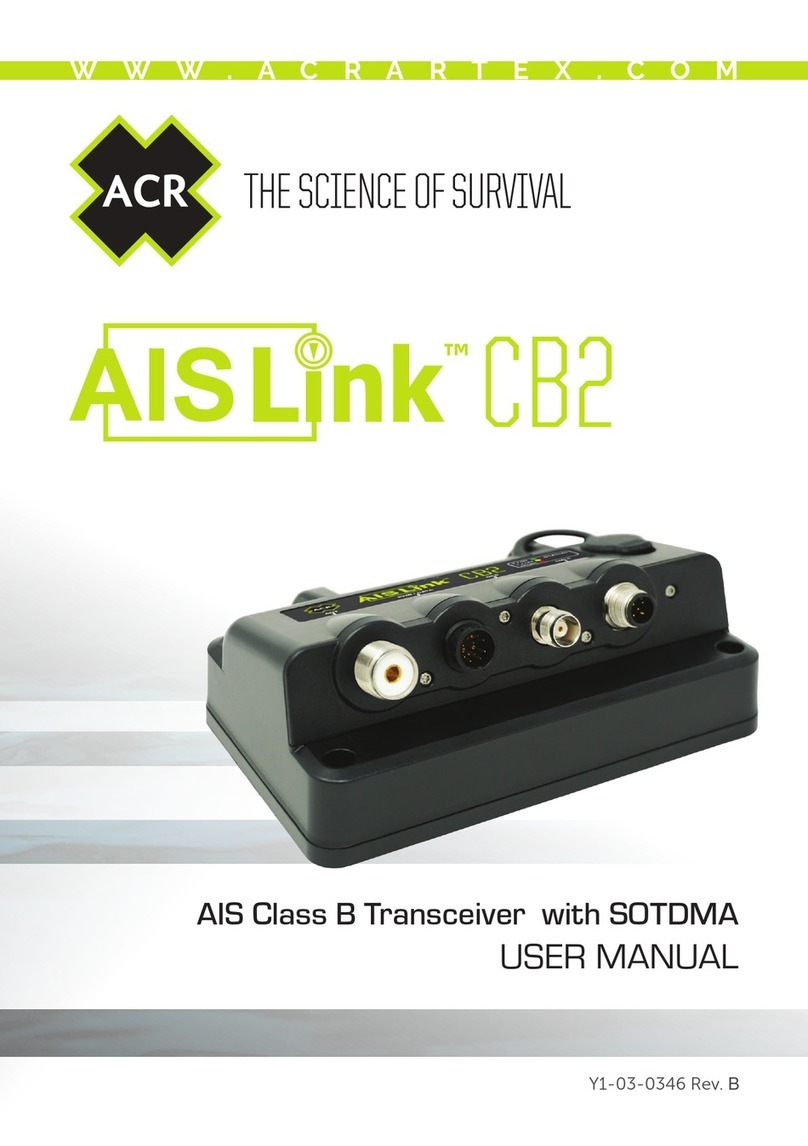
ACR Electronics
ACR Electronics AISLink CB2 user manual

